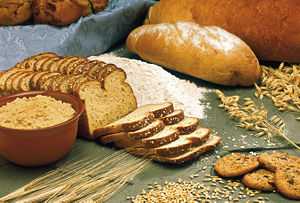Healthy eating habits/Fibre: The Forgotten Nutrient
Fibre is the part of plant food that cannot be digested in the gut. It is an essential part of the human diet necessary for digestive health.

Types of Fibre edit
There are three types of fibre - insoluble fibre, soluble fibre and resistant starch.
- Insoluble fibre. Insoluble fibre acts to speed up the digestive system helping to prevent constipation. It is found in wheat products such as bread, pasta and breakfast cereal, and other grains including rye, brown rice and quinoa
- Soluble fibre. Soluble fibre acts to slow down the digestive system, making you feel fuller for longer. It also lowers 'bad' cholesterol. It is found in oats, fruits, vegetables and legumes.
- Resistant starch. Resistant starch provides some of the benefits of insoluble fibre and some of the benefits of soluble fibre. It feeds good gut bacteria, promoting good digestive health. It is found in wholegrains, legumes and cooked and cooled starchy foods including potatoes, pasta and rice.
All three types of fibre are needed for digestive health. Try to eat balanced diet with a range of fibre rich foods to make sure you get all three types.
Sources of Fibre edit
Fibre is found in plant based foods. Sources include wholegrains, fruits, vegetables, legumes, breakfast cereals, dried fruits and nuts. Note while being sources of fibre, dried fruits are high in sugar and nuts are very high in kilojoules. Both should be consumed in moderation. Some good sources are shown below.
| Food | Serving size (kilojoules) | Fibre (g) |
|---|---|---|
| Bread - wholemeal + grain | 30 g (360 kJ) | 2.3 |
| All Bran breakfast cereal | 45 g (620 kJ) | 13.0 |
| Apple | 1 medium - 150 g (300 kJ) | 3.5 |
| Peas - frozen | 1/2 cup - 75g (220 kJ) | 3.3 |
| Chickpeas - canned | 1/2 cup - 75 g (340 kJ) | 4.3 |
| Dried figs | 2 figs - 30 g (30 kJ) | 4.3 |
| Almonds | 30 g (750 kJ) | 2.6 |
Benefits of Fibre edit
Fibre is well known for preventing constipation. Low fibre diets have also been associated with a number of other health conditions. These include
- Haemorrhoids
- Diverticulitis
- Irritable bowel syndrome
- Obesity
- Coronary artery disease
- Diabetes
- Some cancer including colon cancer
- Allergies
Fibre recommendations edit
The Australian Dietary Guidelines recommend at least 25 g/day of total fibre for women and 30g/day for men. A sudden increase in fibre may cause digestive discomfort, bloating and flatulence and it is therefore recommended that dietary changes be made slowly. Tips for increasing fibre intake include
- Swapping to wholemeal or wholegrain bread. If you must have white bread, choose a fibre enriched variety
- Choose wholegrain carbohydrates such as wholemeal pasta, brown rice or quinoa.
- Choose a breakfast cereal with at least 8% fibre
- Opt for higher fibre snacks like fresh fruit, dried fruit, nuts or wholegrain crackers and vegetables with hummus.
- Where possible keep the skin on fruits and vegetables (such as apples and potatoes). A large percentage of the fibre is found in or just below the skin.
Other Tips edit
- To check the fibre content of a food, look for the nutrition information panel. It is not compulsory to include dietary fibre in this panel, however most foods that contain fibre will include it. You may need to consider how much of the food you actually eat (for example, a serve of oats might say half a cup but if you eat a whole cup, you need to double the serving size). Figure 1 shows a nutrition information panel. For more information on label reading and healthy food choices, see chapter 36 - Healthy eating habits/Reading Food Labels to Make Healthy Food Choices
- Generally, when comparing similar foods (e.g. different varieties of bread), the food with the higher fibre content will be the healthier option. As well as the direct benefit of fibre, foods higher in fibre are often less processed and lower in sugar or fat than low fibre alternatives.
- Diets higher in fibre have been shown to provide a range of health benefits over low fibre diets. However it is important to note studies are usually investigate a diet naturally high in fibre rather than diets that include a fibre supplement. Most foods naturally high in fibre are also high in other nutrients. For optimal health, try to meet fibre recommendations by consuming a range of foods high in fibre including wholegrains, fruits, vegetables and legumes.
More Information edit
For more information on the different types of fibre and fibre sources, visit "Are you eating right for your digestive health"
For the Victorian Government's recommendations for fibre, see "Fibre in food"
For a full list of the amount of fibre found in different foods click here, then click "Browse nutrient list" and select "Dietary fibre"
References edit
[1] Better Health Channel. (2014). Fibre in food. Retrieved from http://www.betterhealth.vic.gov.au/bhcv2/bhcarticles.nsf/pages/Fibre_in_food
[2] Burgen (2011). Are you eating right for your digestive health. Retrieved from http://www.glnc.org.au/wp-content/uploads/2011/04/Consumer-brochure-4pp-A5-V7-FINAL2.pdf
[3] Food Standards Australian and New Zealand. (2013). NUTTAB 2010 Online Searchable Database. Retrieved from http://www.foodstandards.gov.au/science/monitoringnutrients/nutrientables/nuttab/Pages/default.aspx